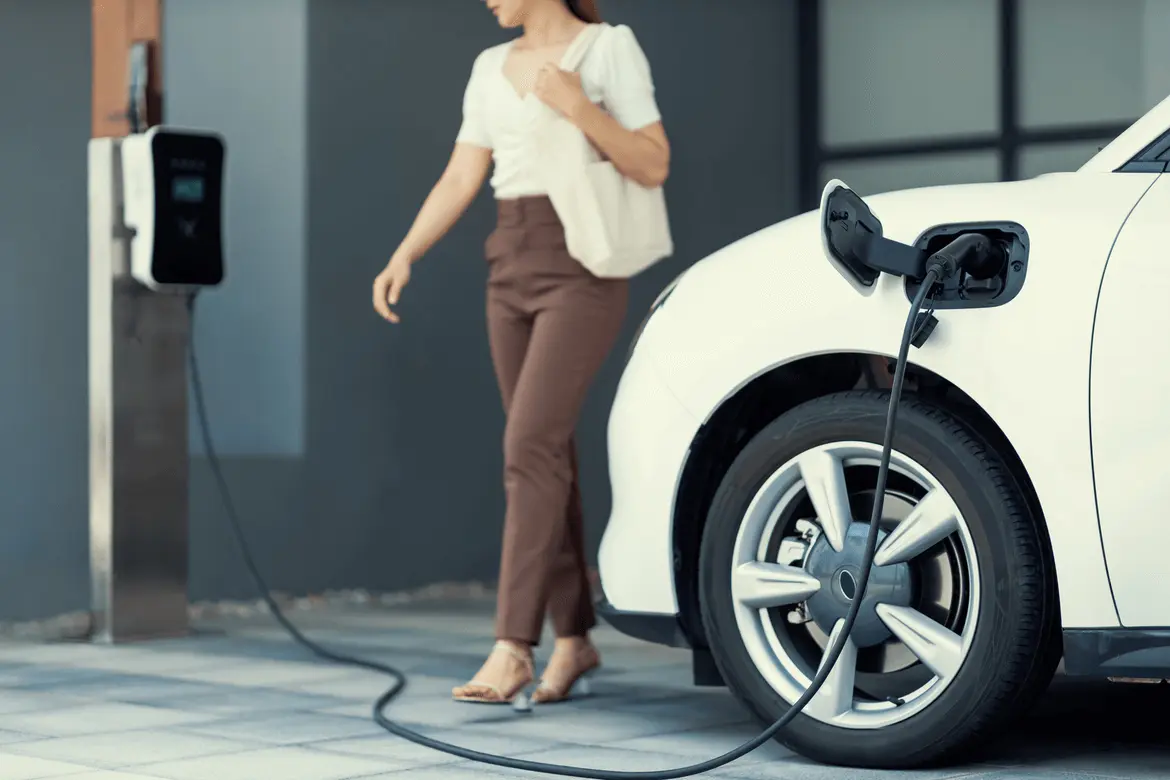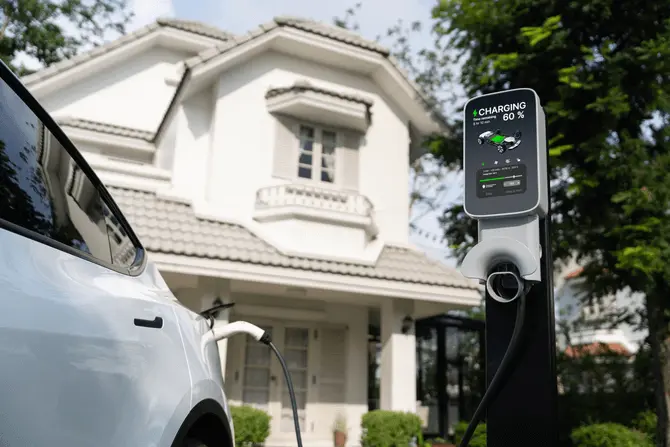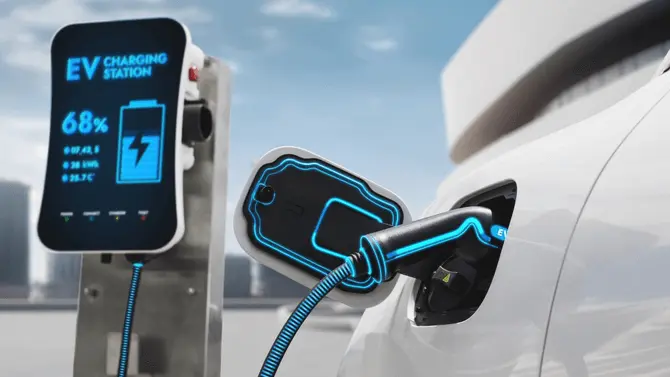Electric Car Charging at Home and On-the-Go

Electric cars are becoming increasingly popular around the world because they are environmentally friendly, economical in the long run, and offer comfortable driving. All EV fans need to know how to charge their vehicles properly to enjoy all the benefits these electric cars offer. In this article, we at AutoBidMaster will uncover the main aspects of EV charging at home and on the road.
In the event you’re looking for a cheap EV, there is no better solution than to buy one with AutoBidMaster. Our online auto auctions provide access to more than 300,000 used vehicles, including a wide range of electric cars, available for bidding. Register on our website, browse the inventory, and win your next car, motorcycle, jet ski, or any other vehicle type with us!
Charging an Electric Car at Home

This is the most convenient and cheapest way to recharge your electric car’s battery. You can plug in your electric car at any time, regardless of the availability of public charging stations. However, you need to have special equipment and follow some simple rules.
Ways to Charge EVs at Home
We can outline two main types of home chargers that EV owners usually use: a regular outlet and a charging station.
Level 1 Charging
A common 120-volt AC outlet is the easiest and most budget-friendly way to charge an electric vehicle. This is also called Level 1 charging. You only need to have a cable that is compatible with your car and the outlet. The cable is usually provided with an electric car during its purchase.
This method also has its drawbacks, particularly the low charging speed. According to U.S. Department of Transportation data, Level 1 chargers can require around 40–50 hours to charge a Battery Electric Vehicle (BEV) up to 80 percent from empty, while it takes 5–6 hours for a Plug-in Hybrid Electric Vehicle (PHEV). A high load on the power grid should also be taken into account, as there is a risk of overheating or short-circuiting when using a common 120-volt outlet.
Level 2 Charging
Another possible choice is a specialized device created to power up an electric vehicle, also known as Level 2 charging. It provides a 240-volt (208V for commercial applications) capacity, which results in faster EV recharging.
The Level 2 station has many advantages, including a high charging speed. Depending on the station power capacity, it can reach 60 miles (100 km) of range per hour of charging. As the U.S. Department of Transportation states, the Level 2 chargers can power up a Battery Electric Vehicle (BEV) up to 80 percent from empty within 4–10 hours and a Plug-in Hybrid Electric Vehicle (PHEV) in 1–2 hours.
Level 2 stations are also beneficial to use because of their safety, protection against voltage drop, and control they give you over the charging process. These charging stations come at a price, though. These are more expensive, require professional installation, and may require additional permits from the energy supplier. So, it’s always a wise idea to have a consultation with professionals before deciding on this EV charging option.
How to Choose an Option for Home EV Charging
When deciding on a solution for home charging, you should consider the following factors:
- The type and model of your electric car. Different EVs have different types of connectors and different battery capacities. You should make sure that your charger is compatible with your car and can provide it with optimal charging.
- Frequency and duration of driving. If you often drive long distances, you need fast charging so that you don’t spend a lot of time topping up your battery. In this case, you should choose a high-power charging station. If you rarely drive or drive only for short distances, a regular outlet may be enough to charge your car overnight.
- Budget and accessibility. A regular outlet is the cheapest way to charge an electric car, but it has its limitations. A charging station is a more efficient and safer way, but it requires more money to purchase, install, and maintain. You should consider how much you are willing to spend on charging your electric vehicle and what resources you have available.
By taking into account the mentioned factors, you can pick the best solution for your EV home charging.
Also read: Debunking Common Myths About Electric Cars
Charging Your EV on the Road

You can use public charging stations, which are located all over the world, or private charging points if you have access to them. Both of these options have some nuance to using them.
Types of Public Charging Stations
Public charging stations are a network of specialized devices accessible to all electric vehicle drivers, categorized into three main types based on power and charging speed:
- Low-power charging stations. Common and cost-effective, these are found in parking lots, shopping centers, hotels, etc. They range from 3 to 22 kW and typically charge an electric vehicle in 4–8 hours, making them ideal for everyday or overnight charging.
- Medium-duty charging stations. Faster and more efficient, these are located at gas stations, highways, airports, etc. They offer 22 to 50 kW of capacity and charge an electric vehicle in 1–2 hours on average. This makes them suitable for medium-distance travel or quick daily charges.
- High-power charging stations. The fastest and most potent are found at dedicated sites like Tesla Supercharger, Ionity, or Fastned. With capacities ranging from 50 to 350 kW, they can charge an electric vehicle in 15–30 minutes on average, meaning they are perfect for long-distance trips or urgent charging needs.
When you need to charge your EV while on the road, consider these options for fast and safe charging.
How to Choose a Public Charging Station
If you need to make use of a public charging station, consider the following factors:
- The type and model of your electric vehicle. Not all electric vehicles are compatible with all types of public charging stations. You should check what type of connector your car has and what maximum power it can accept. You should also have the appropriate cable or adapter, if needed.
- Location and accessibility of the charging station. Plan your route so that you have a charging station nearby when your battery is almost empty. You should also check whether the charging station is working and has the required connector. To do this, you can use special apps or websites such as PlugShare, ChargeMap, or Electromaps.
- The price and payment methods of the charging station. The price of charging an electric vehicle at public charging stations can vary depending on the capacity, operator, time of day, and other factors. Compare the prices of different charging stations and choose the most favorable one for you.
Knowing these factors makes it easy to pick the most suitable public EV charging option for your car.
Wrapping Up
Charging an electric vehicle is easy if you follow some basic rules. You can charge at home or at a station on the road, choosing from different power levels based on your needs. Consider factors like connector type, location, and pricing when selecting a station, and use apps or websites to find nearby options.
If you want to buy your next EV at a fraction of the price, AutoBidMaster invites you to take part in our online car auctions. You just need to register on our platform, upload a copy of your government-issued ID or passport, place a security deposit, and participate in our online car auctions! Don’t hesitate to contact us online if you have any questions or concerns. You can also call us at +1 (503) 298-4300 (4:00 AM–4:00 PM PST, weekdays). Also ClearVin offers fast and easy access to the original BMW Window Sticker by VIN.
We are on a mission to help our customers give a second life to used cars by simplifying auto auctions for all. – AutoBidMaster
- AutoBidMaster Automotive News: April 2024 Digest - April 25, 2024
- Electric Car Charging at Home and On-the-Go - April 18, 2024
- Why Choose Used Can-Am Quads - April 11, 2024